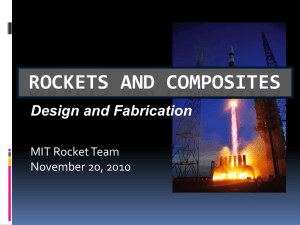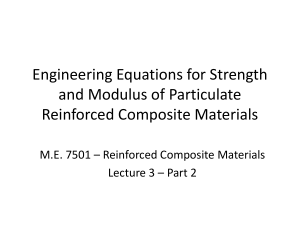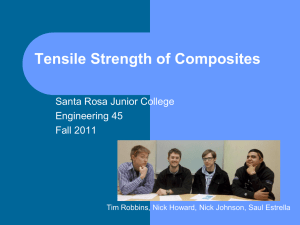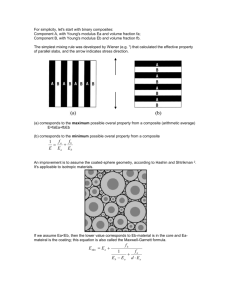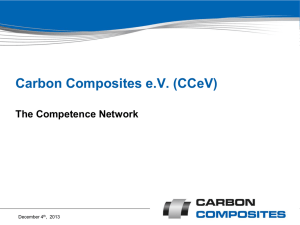Paper Number - Strathprints
advertisement
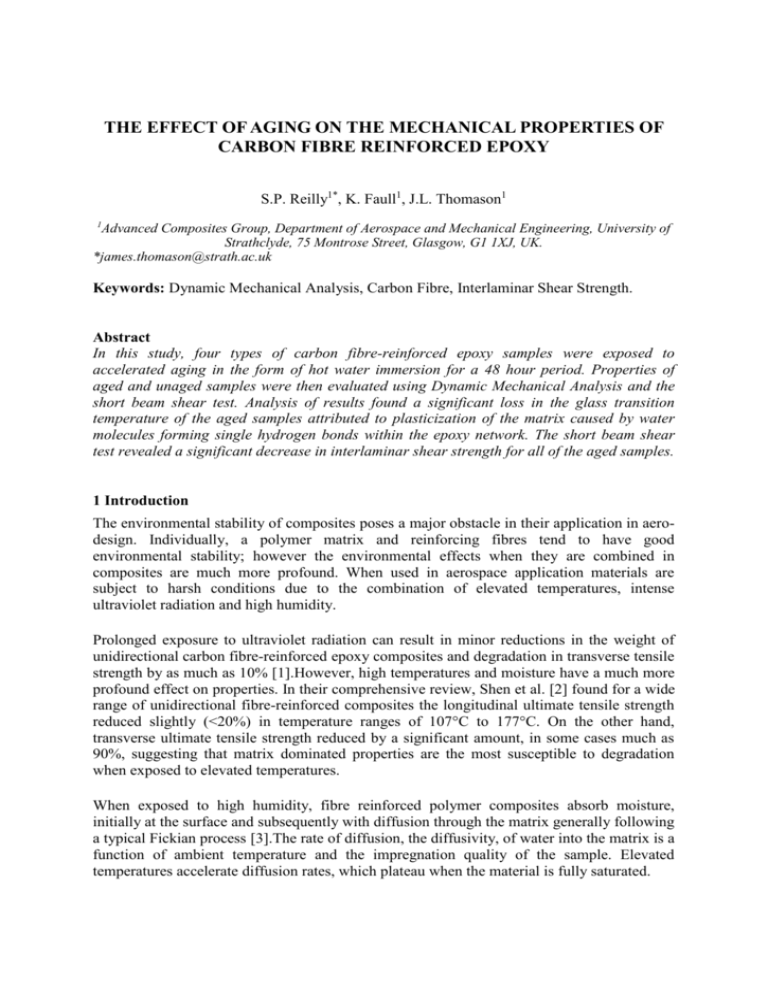
THE EFFECT OF AGING ON THE MECHANICAL PROPERTIES OF CARBON FIBRE REINFORCED EPOXY S.P. Reilly1*, K. Faull1, J.L. Thomason1 1 Advanced Composites Group, Department of Aerospace and Mechanical Engineering, University of Strathclyde, 75 Montrose Street, Glasgow, G1 1XJ, UK. *james.thomason@strath.ac.uk Keywords: Dynamic Mechanical Analysis, Carbon Fibre, Interlaminar Shear Strength. Abstract In this study, four types of carbon fibre-reinforced epoxy samples were exposed to accelerated aging in the form of hot water immersion for a 48 hour period. Properties of aged and unaged samples were then evaluated using Dynamic Mechanical Analysis and the short beam shear test. Analysis of results found a significant loss in the glass transition temperature of the aged samples attributed to plasticization of the matrix caused by water molecules forming single hydrogen bonds within the epoxy network. The short beam shear test revealed a significant decrease in interlaminar shear strength for all of the aged samples. 1 Introduction The environmental stability of composites poses a major obstacle in their application in aerodesign. Individually, a polymer matrix and reinforcing fibres tend to have good environmental stability; however the environmental effects when they are combined in composites are much more profound. When used in aerospace application materials are subject to harsh conditions due to the combination of elevated temperatures, intense ultraviolet radiation and high humidity. Prolonged exposure to ultraviolet radiation can result in minor reductions in the weight of unidirectional carbon fibre-reinforced epoxy composites and degradation in transverse tensile strength by as much as 10% [1].However, high temperatures and moisture have a much more profound effect on properties. In their comprehensive review, Shen et al. [2] found for a wide range of unidirectional fibre-reinforced composites the longitudinal ultimate tensile strength reduced slightly (<20%) in temperature ranges of 107°C to 177°C. On the other hand, transverse ultimate tensile strength reduced by a significant amount, in some cases much as 90%, suggesting that matrix dominated properties are the most susceptible to degradation when exposed to elevated temperatures. When exposed to high humidity, fibre reinforced polymer composites absorb moisture, initially at the surface and subsequently with diffusion through the matrix generally following a typical Fickian process [3].The rate of diffusion, the diffusivity, of water into the matrix is a function of ambient temperature and the impregnation quality of the sample. Elevated temperatures accelerate diffusion rates, which plateau when the material is fully saturated. Shen at al also reviewed the effect of humidity in unidirectional fibre-reinforced composites. They concluded that longitudinal properties show little reaction to increasing moisture content whilst transverse properties reduce significantly. Therefore also indicating that matrix dominated properties are more susceptible to degradation from environmental exposure. A number of recent studies also support this [4-6][6]. Reduction in the interfacial shear strength [7] and lowering of the composites glass transition temperature [5]are also result from water ingress. The aim of this study is to analyse the degradation caused by long term environmental exposure, simulated by accelerated aging of four types of carbon fibre reinforced epoxy composites. From previous studies it is clear that matrix dominated properties suffer the greatest degree of degradation therefore this study will focus on the changes in properties of the epoxy matrix and the fibre/epoxy interphase. 2 Materials and testing methods 2.1 Materials and Sample preparation Four types of carbon fibre reinforcement were used in this study, two IM-type fibres from different manufacturers. The fibres from manufacturer A are donated as IMA1 and IMA2 and the fibres from manufacturer B, IMB1 and IMB2. The samples were made using unidirectional pre-preg with a thermoplastic-toughened highly cross-linked epoxy resin. Unidirectional laminates were made in a [90]14 sequence, which was debulked for 2 hours half way through the stacking. An H/400 AC Autoclave Furnace was using to cure the samples. The cure cycle was as follows; auto clave temperature ramped at 2°C/min to 180°C while the pressure is ramped at 0.35Bar/min to 6.5 Bar. It was then held at these conditions for 6 hours before being cooled at 10°C/min. The sample dimensions were length 57mm, width 12mm and thickness 2mm. The samples were cut from the laminate using water jet cutting. It was found that samples which had been cut using a diamond saw had cracks in the laminate, where as water jet cut samples displayed no damage. The water jet cut surface was however rougher than that of the diamond cut samples. 2.2 Accelerated Aging The method of accelerated aging used was immersion in boiling water under reflux for 48 hours, therfore combining exposure of elevated temperature and moisture. The experimental setup is shown in Figure 1. The equipment used was a ThermoFisher Scientific Electromantle, conical flask, condenser, clamp stand and rubber tubing to connect the water supply to the condenser. Figure 1. Reflux apparatus setup for accelerated aging After a sample was conditioned, it was immediately placed in glass sealed jar containing water to prevent desorption from occurring. In total 8 samples were conditioned; two of each type of sample. The weights of the conditioned samples were then measured using a Mettler Toledo balance which has an accuracy of ±0.001mg. 2.3 Dynamic Mechanical Analysis (DMA) DMA (Q800 TA Instruments) was used to measure the sample’s Storage Modulus and Loss Modulus. The temperature was ramped at 3°C/min to 300°C and then cooled. The initial conditions for the run were a frequency of 1Hz and amplitude of 20 µm. The preload was 0.1N. The sample can be seen in situ in Figure 2. Figure 2. Sample secured in the three-point bending clamp. The longitudinal direction of the fibres is parallel to the length of the sample. 3.Results and Discussion 3.1 Dynamic Mechanical Analysis Storage Modulus and Loss Modulus values measured by the DMA are shown in Figures 3 and 4. Figure 3 indicates that accelerated aging (conditioning) has no effect on the Storage Modulus of the samples. As the storage modulus is related to the epoxy network density [8]this suggests there is no significant loss in the network structure due to environmental exposure. The effect of accelerated aging on the Loss Modulus is more apparent and is illustrated in Figure 4. When comparing conditioned and unconditioned samples, there is a clear shift in the peak of the loss modulus curve towards a lower temperature range. Figure 3. Storage modulus against temperature for unconditioned (UC) and conditioned (C) samples Figure 4. Loss modulus against temperature for unconditioned (UC) and conditioned (C) samples ECCM15 - 15TH EUROPEAN CONFERENCE ON COMPOSITE MATERIALS, Venice, Italy, 24-28 June 2012 From the data obtained, the glass transition temperature (Tg) of a material can be found from either the peak of the loss modulus curve or the peak of the tan delta curve. The T g is often different for each method with the disparity of values depending on the material being tested [9]. In the results shown these two features both shift towards lower temperatures after aging. The value of the average Tg for each type of sample was evaluated using the Loss Modulus peaks and the Tan δ peak are presented in Table 1. From these values the reduction in Tg ranges from approximately 6 to 17%. This reduction in Tg is caused by plasticization of the epoxy matrix due to water absorption[10]. Water absorbed by polymer matrixes fall into two categories: ‘Bound’ water, which creates strong polar interactions with hydrophilic groups within the epoxy network, and ‘Free’ water which presents itself in the free volume of the matrix (i.e. micro-voids and capillaries)[11]. Figure 5. Tan Delta plotted against temperature for unconditioned (UC) and conditioned (C) samples Both these types of bonding occur more readily in reinforced epoxy composites due to preferential water absorption at the reinforcement/matrix interphase [12].There are two types of bound water that have been identified[13], [14].Type 1 is the initial bonding of water molecules to the polymer network by single hydrogen bonds. These bonds can disturb the inter-chain Van der Waal forces in the polymer network and result in increased chain mobility [10].This mobility is likely to be the foundation of the plasticization of the matrix, and therefore the reduction in Tg, displayed by the results. Type 2 bonding is where water molecules form double hydrogen bonds with the polymer network due to prolonged exposure times. These bonds have higher activation energy than Type 1 bonds and act as cross-links in between polymer chains. Presence of this type of bonding is seen in Figures 5 and 6 by the ‘shoulders’ at either side of the Tan Delta peak. As the DMA analysis exposed the samples to elevated temperatures after the conditioning process desorption is likely to have occurred. Due to its lower activation energy, Type 1 bounded water would dissipate from the matrix first, leaving only the Type 2 bounded water which requires greater temperatures for desorption due to its higher activation energy. This may be the reason for the less apparent shoulder at lower temperatures in Figure 5 and 6; as Type 1 bound water would still be present, causing plasticization. In addition the bases of the peaks are wider which suggests the formation of a less homogeneous structure. This could be attributed to the uneven distribution of type 2 bonding throughout the matrix, making some regions more rigid than others. 5 ECCM15 - 15TH EUROPEAN CONFERENCE ON COMPOSITE MATERIALS, Venice, Italy, 24-28 June 2012 Figure 6. Tan Delta plotted against temperature for unconditioned (UC) and conditioned (C) samples IMA1 IMA2 IMB1 IMB2 Tg Loss Modulus Unconditioned Conditioned 203 171 196 170 198 170 197 171 Tg Tan Delta Unconditioned 218 210 211 208 Conditioned 204 180 178 179 Table 1: The average Tg for each sample determined by the Loss Modulus and Tan Delta peaks. 3.2 Moisture Content Table 2 shows the moisture content of each sample after aging. The IMA1 samples absorbed slightly more moisture than the other fibre-reinforced epoxy samples. Sample IMA1 IMA2 IMB1 IMB2 MC (%) 1.25 1.08 1.07 1.11 Table 2: The average moisture content of each sample type after aging. From Table 2 IMA1 samples also show the largest reduction in Tg evaluated from the Loss Modulus peaks and the smallest reduction in Tg evaluated from the Tan Delta peaks. Therefore in this case the higher moisture content has resulted in the generation of more single and double hydrogen bonds throughout the epoxy network resulting in a greater degree of plasticization at lower temperatures, where the loss modulus peak was recorded, and a higher cross-linking density at higher temperatures, where the Tan Delta peak was recorded. 6 ECCM15 - 15TH EUROPEAN CONFERENCE ON COMPOSITE MATERIALS, Venice, Italy, 24-28 June 2012 A correlation therefore is present between moisture content and the extent of Type 2 bonding incurred. Figure 7. Interlaminar shear strength results 3.3 Interlaminar Shear Strength Short beam shear tests were carried out on samples conditioned and unconditioned samples after they had been ran in the DMA. The results can be seen in Figure 7. A base line test was also performed on samples which did not undergo any type of conditioning or heat treatment. All of the samples suffered a loss of ILSS after conditioning. The IMA1 sample has the smallest difference between conditioned and unconditioned ILSS values; however it does have the overall lowest strength for both conditioned and unconditioned values. This supports the moisture content results and suggests that the greater the amount of moisture absorbed, the more damage is done at the interface. 4. Conclusions This study used the method of accelerated aging, by immersion in boiling water, to evaluate the degradation experienced by carbon fibre-reinforced epoxy samples for use in aerospace applications. DMA was employed to determine the changes in the samples elastic and damping properties through measuring the storage modulus and loss modulus respectively. Results showed a reduction in the glass transition temperature for all samples tested attributed to plasticization of the epoxy matrix caused by water molecules forming single hydrogen bonds with the epoxy network. Results also presented ‘shoulders’ on the tan delta curves suggesting that water ingress has also produced double hydrogen bonds, reinforcing the epoxy matrix by the formation cross-linking sites; the disparity of these cross-linking sites resulting in a less homogeneous structure. These results were supported by the results of ILSS testing. 7 ECCM15 - 15TH EUROPEAN CONFERENCE ON COMPOSITE MATERIALS, Venice, Italy, 24-28 June 2012 References [1] [2] [3] [4] [5] [6] [7] [8] [9] [10] [11] [12] [13] [14] B. G. Kumar, R. P. Singh, and T. Nakamura, “Degradation of Carbon Fibre-Reinforced Epoxy Composites by Ultraviolet Radiation and Condensation ,” Journal of Composite Materials, vol. 45, no. 18, pp. 1901-1918, 2002. C. H. and S., G. S Shen, “Effects of Moisture and Temperature on the Tensile Strength of Composite Materials.,” Journal of Composite Materials, vol. 11, p. 2, 1976. J. J. Imaz, J. L. Rodriguez, A. Rubio, and I. Mondragon, “Hydrothemal environment influence on water diffusion and mechanical behaviour of carbon fibre/epoxy laminates,” Journal of Materials Science Letters, vol. 10, pp. 662-665, 1991. A. Bismarck, M. Hofmeier, and G. Dörner, “Effect of hot water immersion on the performance of carbon reinforced unidirectional poly(ether ether ketone) (PEEK) composites: Stress rupture under end-loaded bending,” Composites Part A: Applied Science and Manufacturing, vol. 38, no. 2, pp. 407-426, Feb. 2007. R. Selzer and K. Freidrick, “Mechanical properties and failure behaviour of carbon fibre-reinforced polymer composites under the influence of moisture,” Composites Part A: Applied Science and Manufacturing, no. 96, pp. 595-604, 1997. C.-H. Shen and G. S. Springer, “Environmental Effects on the Elastic Moduli of Composite Materials,” Journal of Composite Materials, vol. 11, no. 3, pp. 250-264, Jul. 1977. D. A. Biro, G. Pleizier, and Y. Deslandes, “Application of the microbond technique: Effects of hygrothermal exposure on carbon-fiber/epoxy interfaces,” Composites Science and Technology, vol. 46, no. 3, pp. 293-301, Jan. 1993. T. Murayama and J. P. Bell, “Relation between the network structure and dynamic mechanical properties of a typical amine-cured epoxy polymer,” Journal of Polymer Science Part A-2: Polymer Physics, vol. 8, no. 3, pp. 437-445, Mar. 1970. M. Akay, “Aspects of Dynamic Mechanical Analysis in Polymeric Composites,” Composites Science and Technology, vol. 47, pp. 419-423, 1993. S. Alessi, D. Conduruta, G. Pitarresi, C. Dispenza, and G. Spadaro, “Accelerated ageing due to moisture absorption of thermally cured epoxy resin/polyethersulphone blends. Thermal, mechanical and morphological behaviour,” Polymer Degradation and Stability, vol. 96, no. 4, pp. 642-648, Apr. 2011. D. Hayward, E. Hollins, P. Johncock, I. McEwan, R. A. Pethrick, and E. A. Pollock, “The cure and diffusion of water in halogen containing epoxy/amine thermosets,” Polymer, vol. 38, no. 5, pp. 1151-1168, 1997. P. Gonon, A. Sylvestre, J. Teysseyre, and C. Prior, “Combined effects of humidity and thermal stress on the dielectric properties of epoxy-silica composites,” Materials Science and Engineering: B, vol. 83, no. 1–3, pp. 158-164, Jun. 2001. J. Zhou and J. P. Lucas, “The effects of a water environment on anomalous absorption behavior in graphite/epoxy composites,” Composites Science and Technology, vol. 53, no. 1, pp. 57-64, Jan. 1995. Z. H. Ping, Q. T. Nguyen, S. M. Chen, J. Q. Zhou, and Y. D. Ding, “States of water in different hydrophilic polymers Ð DSC and FTIR studies,” vol. 42, 2001. 8
